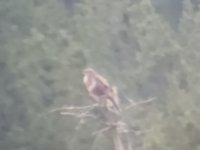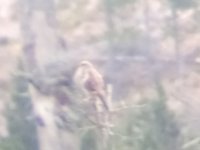curlewsandpiper1980
Well-known member
Location NE Scotland, inland, mixed habitat heathland and dense conifer plantation.
Today, besides seeing several pairs of displaying buzzards, I saw a pair of two unidentified raptors and what was remarkable on them was:
- their bright white tail base. As the birds soared and reflected sunlight, the tail base shone remarkably white in several occasions. I don't experience this with the many buzzards I see every week.
Besides this I noted these other traits:
The area is known to contain breeding goshawk, hen harrier and merlin. As well as osprey in summer. So I walk there regularly in hopes of spotting those scarcer species, while hiking on main paths/ road tracks (so I don't disturb any of those species). Eagles would be more uncommon in this location.
I don't think that this pair were goshawks (I would expect a long tail and also short broad wings but because of distance I could have been fooled). I have seen unidentified hawks flying in the area before, above conifer woods, but I was never able to positively identify those as goshawks instead of sparrowhawks. These weren't hawks.
I could have been a pair of rough legged buzzards. Especially because of a brilliant white tail was stood out. But is there any chance that a common buzzard could present an unusual bright white tail base? Rough legged are possible in the area.
I am also relatively unfamiliar with hen harrier. But to the best of my knowledge I wouldn't expect them to soar high and I would expect a long narrow tail.
No photo. Sighting took 40 seconds and I remained focused in the eyepiece of the scope. The raptors were quite far, so I would have probably ignored these as an unidentified pair of raptors or unconfined buzzards if it wasn't for the bright white tail base.
Any ID guesses?
1
Today, besides seeing several pairs of displaying buzzards, I saw a pair of two unidentified raptors and what was remarkable on them was:
- their bright white tail base. As the birds soared and reflected sunlight, the tail base shone remarkably white in several occasions. I don't experience this with the many buzzards I see every week.
Besides this I noted these other traits:
- The tail was broad, buzzard-like (unlike a hawk or falcon).
- The silhouette was not dissimilar from that of a buzzard but wings were a bit narrower. This also caught my attention. But it wasn't any falcon. I initially even suspected hen harrier.
- These birds were first spotted flying above conifer plantation and 10 second later soaring high above the adjacent heath (and after a minute, they were too far to continue looking)
- The flying pattern was nothing of remark. I didn't catch any of V pattern of common buzzard, nor any distinctive different flying style.
The area is known to contain breeding goshawk, hen harrier and merlin. As well as osprey in summer. So I walk there regularly in hopes of spotting those scarcer species, while hiking on main paths/ road tracks (so I don't disturb any of those species). Eagles would be more uncommon in this location.
I don't think that this pair were goshawks (I would expect a long tail and also short broad wings but because of distance I could have been fooled). I have seen unidentified hawks flying in the area before, above conifer woods, but I was never able to positively identify those as goshawks instead of sparrowhawks. These weren't hawks.
I could have been a pair of rough legged buzzards. Especially because of a brilliant white tail was stood out. But is there any chance that a common buzzard could present an unusual bright white tail base? Rough legged are possible in the area.
I am also relatively unfamiliar with hen harrier. But to the best of my knowledge I wouldn't expect them to soar high and I would expect a long narrow tail.
No photo. Sighting took 40 seconds and I remained focused in the eyepiece of the scope. The raptors were quite far, so I would have probably ignored these as an unidentified pair of raptors or unconfined buzzards if it wasn't for the bright white tail base.
Any ID guesses?
1








